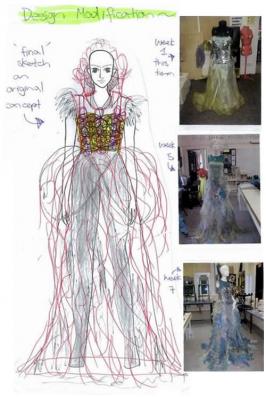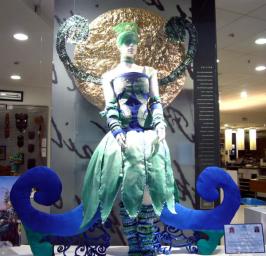Wearable arts collaboration: Delivery
CP1002
Kay began working on her project in February, and was joined by Megan and Ellen in May. Their teachers kept in regular contact to discuss the students' progress and what still needed to be done. Barbara and Kylie encouraged the girls to keep in contact with each other, and to visit Te Papa together for client meetings. However, as meeting proved difficult the girls mainly discussed their project via email.
Their brief was quite open – To create a wearable arts outfit and window display. The students had to consider the Te Papa 10th anniversary slogan '10 years and onwards' and use colours which represented Te Papa. Perhaps because the brief gave them a lot of freedom, the girls found it quite difficult to define exactly what they needed to represent. After discussion with each other, their teachers, and Jan, they eventually decided that the idea of sustainability and protecting the environment for the future fitted with 'looking forward' and they adopted Jan's recommendation to use blue and green to represent Te Papa's location by the sea.
Kylie spent time with the students discussing window display work and giving them tips on how to create an effective display – as they developed the costumes the girls had to bear in mind that they would need to complement the Te Papa-designed background for the window. After installing their work, Kay, Ellen and Megan surveyed people studying the display and asked their opinion of the garments.
Kay
"Kay's work was absolutely top of the range, it was incredibly technically beautiful."
Jan Morris
Kay researched the World of Wearable Art (WOW) show, other window displays, the Te Papa brand, and historical costumes. She also surveyed people who had attended or participated in previous WOW shows, to find out what they most enjoyed about the costumes. She had been advised by her teacher that she should come up with a brand new look and ideas, in order to stand out from the previous displays, and that her work would be more art than fashion.
While she considered design ideas, Kay trialled a variety of fabric manipulation techniques – making samples of bubbled, crinkled, sewn, and knitted fabrics. She also trialled some wash-away techniques and practised drying fabrics in 3D shapes.
Kay discussed her project and ideas with experts, such as Technology department technologist Marie Patterson, who has previously entered WOW, and technologist Lyndal Sheat, who works at a local embroidery shop. She showed her design ideas to her client and they decided she would develop the 'flowing dress with tights' combination; Kay sketched her concept designs and again asked her client which she preferred.
The final design featured a green under-dress decorated with flowers on the bodice, and with wire around the hips to give bulk. The over-skirt would be layers of sheer fabric in white and then gold covered, and the costume would be finished with a collar in metallic blue/green, and silver tights.
Lyndal had suggested 'hot cutting' as an interesting technique that might suit the costume, and after trialling it Kay decided to incorporate this as the detail on her dress. It involved cutting mesh into shapes with a hot poker, free stitching it on the sewing machine, and sewing it on to fabric, but she adapted this process to make it faster.
Kay also trialled some other detailing techniques – trying out the use of beading, fabric patterning, stencilling, bubbling, and buttons on her fabric. She also conducted durability testing in which the fabric was 'tugged', washed, and exposed to the sun. She found that the fabric was weak but kept its colour, and decided it was fit for purpose if she over-locked each section to make it stronger.
Kay refined her design during construction, substituting peacock feathers for the collar and using the collar fabric for the tights, having decided that the silver tights didn't complement the outfit. She also added paua shell to the bodice panels, to go with the 30 wire flowers she had made. She says that construction progressed smoothly, the only problem being that the weight of the outfit made it fall down – she compensated for this by using Velcro and making extra shoulder straps for support.
Megan and Ellen
"Their work was really intensive – there was lots of testing and trialling and making samples. It was great because there was a huge amount of processing, thinking, and anticipation/solving of problems."
Kylie Merrick
Megan and Ellen started work on the project in term 2, and worked through all of term 3 to complete it. They researched wearable art but, to ensure a fresh approach, didn't look at previous Te Papa displays. Kylie suggested that the best approach for a collaborative work might be to create half the outfit each, allowing individual work with a common theme to bind it as an ensemble. The girls continually discussed their work throughout the project, looking at the overall creation and their individual sections. Kylie had instructed them that they must complete everything as if finishing it for a real garment – no hot glue guns!
The girls sketched some concept designs which they discussed with Jan, and after refining these consulted her again as to the final design. This incorporated a koru which would connect the two halves and also reflect the koru shape in the Te Papa thumbprint logo.
Ellen and Megan's window display
Ellen developed the top half for which she used mostly recycled or donated fabrics, such as old curtains from home which she painted and dyed. She made koru-shaped wire frames and wove ripped up fabric, tulle, and ribbon around the wire to create wings.
Ellen created the bodice using draping techniques Рshaping white organza Рusing darts, pleats, and tucks, and lacing the back so that it could be adjusted to fit any size mannequin. She used the sewing machine as a drawing tool to create the sketching on top of the bodice, and appliqu̩ techniques to make koru shapes Рshe says that this also added texture to the garment.
The original sleeve design incorporated light, "floaty" sleeves but Ellen decided they didn't suit the bold colours in the outfit and were too transparent, so instead used cotton covered in white organza.
Ellen experimented with different ideas for the bangles: papier-mâché, which she found quite time-consuming due to the drying/painting/sanding process; plaited fabric, which didn't give the effect she wanted; and strips of plastic cut from plastic jars and bottles. She decided to use the plastic, because it was light-weight and flexible enough to go easily over the mannequin's hands. She covered the plastic strips in fabric which matched the bodice and wings, and Megan's costume.
Ellen made a headband but found it wouldn't stay on the Te Papa mannequin so she replaced it with a headdress made from a pin-tucked piece of nylon netting and held on with elastic.
Megan made her skirt from blue tulle, which she layered "so it would puff out a little bit" and covered with fabric leaves, the outside edge of which she appliquéd with koru spirals. She also made some small and large korus from painted calico, foam, and wire. Megan had painted foam samples to decide which was most effective, and then made samples of the koru using different types of wire and different methods of fixing it to the foam. Her trialling also included testing the qualities of different types of sticky tape and painted tape but she decided these didn't work well, and that she would put the wire onto the foam rather than threading it through.
Megan also trialled a range of decorative stitching to determine which was most suitable for finishing edges to prevent fraying, and which looked best.
The small korus were made out of painted calico and Megan surveyed her classmates as to which colours looked better. She eventually decided to paint them in paua colours of pink and green using the dry-brush method (in which the brush skims the surface of the fabric).
Megan's design included legwarmers which she wanted to have a thick texture. She liked the look of her first sample knitted out of foam and ripped up fabric, but made samples using other techniques and materials, before concluding that the knitted version worked best.
She had planned a belt for the costume, and made samples – plaiting and weaving calico – but, after discussing it with Ellen, decided it would look better without a belt.


